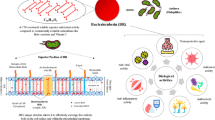Abstract
Natural pigments have several advantages over synthetic colorants. In this study, the production of red pigment produced by Paecilomyces sinclairii in microbial fermentation was demonstrated and the pigment was purified and characterized. The red pigment was produced from submerged fungal fermentation and fractionated by medium pressure flash chromatography. After fractionation, the spectrophotometric characterization of the red pigment revealed an λmax at 520 nm. Antimicrobial activity of the red pigment fraction was also studied against Escherichia coli O157 and Pseudomonas aeruginosa PAO1. The fraction (F2-F6) of the red pigment exhibited broad-spectrum antimicrobial activity in both bacteria. These results demonstrate the potential of this pigment in inhibiting bacterial growth and in food processing and other foodrelated applications.
Similar content being viewed by others
References
Cho, Y. J., J. P. Park, H. J. Hwang, S. W. Kim, J. W. Choi, and J. W. Yun (2002) Production of red pigment by submerged culture of Paecilomyces sinclairii. Lett. Appl. Microbiol. 35: 195–202.
Unagul, P., P. Wongsa, P. Kittakoop, S. Intamas, P. Srikitikulchai, and M. Tanticharoen (2005) Production of red pigments by the insect pathogenic fungus Cordyceps unilateralis BCC 1869. J. Ind. Microbiol. Biotechnol. 32: 135–140.
Kim, D., J. S. Lee, Y. K. Park, J. F. Kim, H. Jeong, T. K. Oh, B. S. Kim, and C. H. Lee (2007) Biosynthesis of antibiotic prodiginines in the marine bacterium Hahella chejuensis KCTC 2396. J. Appl. Microbiol. 102: 937–944.
Jung, H., C. Kim, K. Kim, and C. S. Shin (2003) Color characteristics of monascus pigments derived by fermentation with various amino acids. J. Agric. Food. Chem. 51: 1302–1306.
Kim, C., H. Jung, J. H. Kim, and C. S. Shin (2006) Effect of monascus pigment derivatives on the electrophoretic mobility of bacteria, and the cell adsorption and antibacterial activities of pigments. Colloids Surf. B: Biointerf. 47: 153–159.
Cho, Y. J., H. J. Hwang, S. W. Kim, C. H. Song, and J. W. Yun (2002) Effect of carbon source and aeration rate on broth rheology and fungal morphology during red pigment production by Paecilomyces sinclairii in a batch bioreactor. J. Biotechnol. 95: 13–23.
de Araujo, H. W., K. Fukushima, and G. M. Takaki (2010) Prodigiosin production by Serratia marcescens UCP 1549 using renewable-resources as a low cost substrate. Molecules 15: 6931–6940.
Hacene, H. and G. Lefebvre (1996) HP17, a new pigment-like antibiotic produced by a new strain of Spirillospora. J. Appl. Bacteriol. 80: 565–569.
Fujikawa, H. and R. Akimoto (2011) A new blue pigment produced by Pantoea agglomerans and its production characteristics at various temperatures. Appl. Environ. Microbiol. 77: 172–178.
Schewe, H., A. Kreutzer, I. Schmidt, C. Schubert, and J. Schrader (2017) High concentrations of biotechnologically produced astaxanthin by lowering pH in a Phaffia rhodozyma bioprocess. Biotechnol. Bioproc. Eng. 22: 319–326.
Liu, G. Y. and V. Nizet (2009) Color me bad: microbial pigments as virulence factors. Trends Microbiol. 17: 406–413.
Jeon, J. -Y., S. -Y. Kim, H. -Y. Kim, S. -H. Kim, B. -J. Lee, S. R. Lim, and H. -K. Choi (2018) Effects of agitating culture condition on the growth, metabolic and carotenoid profiles of Lemna paucicostata. Biotechnol. Bioproc. Eng. 23: 23–30.
Yun, M., Y. -K. Oh, R. Praveenkumar, Y. -S. Seo, and S. Cho (2017) Contaminated bacterial effects and qPCR application to monitor a specific bacterium in Chlorella sp. KR-1 culture. Biotechnol. Bioproc. Eng. 22: 150–160.
Zhou, Z. Y. and J. K. Liu (2010) Pigments of fungi (macromycetes). Nat. Prod. Rep. 27: 1531–1570.
Kim, C., H. Jung, Y. O. Kim, and C. S. Shin (2006) Antimicrobial activities of amino acid derivatives of monascus pigments. FEMS Microbiol. Lett. 264: 117–124.
Kongruang, S. (2011) Growth kinetics of biopigment production by Thai isolated Monascus purpureus in a stirred tank bioreactor. J. Ind. Microbiol. Biotechnol. 38: 93–99.
Loret, M. O. and S. Morel (2010) Isolation and structural characterization of two new metabolites from monascus. J. Agric. Food. Chem. 58: 1800–1803.
Babitha, S., C. R. Soccol, and A. Pandey (2007) Effect of stress on growth, pigment production and morphology of Monascus sp. in solid cultures. J. Basic Microbiol. 47: 118–126.
Perez-Tomas, R., B. Montaner, E. Llagostera, and V. Soto-Cerrato (2003) The prodigiosins, proapoptotic drugs with anticancer properties. Biochem. Pharmacol. 66: 1447–1452.
Lebeau, J., M. Venkatachalam, M. Fouillaud, T. Petit, F. Vinale, L. Dufosse, and Y. Caro (2017) Production and new extraction method of polyketide red pigments produced by Ascomycetous fungi from terrestrial and marine habitats. J. Fungi 3: 34–55.
Velmurugan, P., Y. H. Lee, K. Nanthakumar, S. Kamala-Kannan, L. Dufossé, S. A. S. Mapari, and B. -T. Oh (2010) Water-soluble red pigments from Isaria farinosa and structural characterization of the main colored component. J. Basic Microbiol. 50: 581–590.
Author information
Authors and Affiliations
Corresponding author
Rights and permissions
About this article
Cite this article
Choi, J.W., Park, J.P. Water-Soluble Red Pigment Production by Paecilomyces sinclairii and Biological Characterization. Biotechnol Bioproc E 23, 246–249 (2018). https://doi.org/10.1007/s12257-018-0103-1
Received:
Revised:
Accepted:
Published:
Issue Date:
DOI: https://doi.org/10.1007/s12257-018-0103-1




